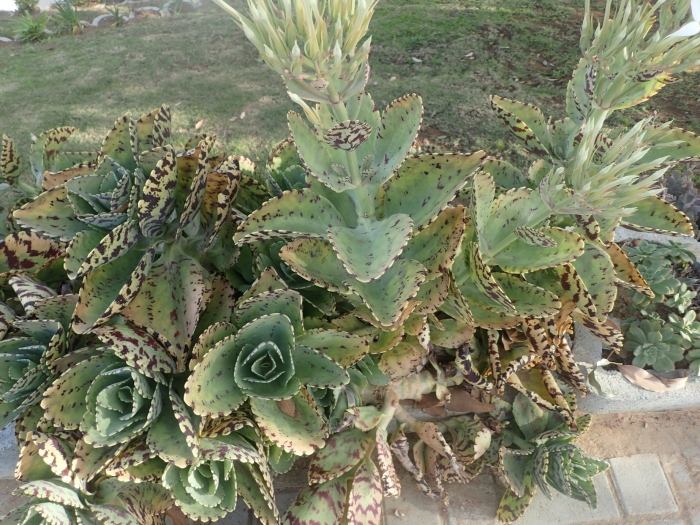Penwiper
(Kalanchoe marmorata)
Penwiper (Kalanchoe marmorata)
/
/

© Nicola van Berkel
CC BY-SA 4.0
Image By:
© Nicola van Berkel
Recorded By:
Copyright:
CC BY-SA 4.0
Copyright Notice:
Photo by: © Nicola van Berkel | License Type: CC BY-SA 4.0 | License URL: http://creativecommons.org/licenses/by-sa/4.0/ | Uploader: nicky | Publisher: iNaturalist |
























Estimated Native Range
Summary
Kalanchoe marmorata, commonly known as Penwiper, is a succulent perennial herb native to the rocky outcrops and grasslands of Central and East Africa, including countries such as Zaire (now Democratic Republic of the Congo), Ethiopia, Sudan, and Somalia. It typically grows up to 16 inches tall and wide, featuring glaucous (grey-green) leaves that are distinctively spotted with purple. During the spring, it produces clusters of starry white flowers that may have pink tinges, adding to its ornamental appeal. The flowers are moderately showy and attract attention when in bloom.
Penwiper is valued for its unique foliage and low-maintenance nature, making it a popular choice for indoor cultivation in temperate regions. It is often used as a decorative houseplant, thriving in conditions that mimic its native habitat. When grown indoors, it requires bright light and good airflow to prevent fungal diseases. It prefers a well-draining cacti/succulent soil mix and should be watered only when the soil has completely dried out, with reduced watering during the winter months to prevent root rot. Kalanchoe marmorata is not frost-tolerant and is hardy to USDA hardiness zone 10. It has been recognized with the Royal Horticultural Society’s Award of Garden Merit, indicating its exceptional qualities as a garden plant. While it is generally pest-resistant, mealybugs and aphids can sometimes be a problem. Overwatering is the most common issue, leading to root rot and fungal infections.CC BY-SA 4.0
Penwiper is valued for its unique foliage and low-maintenance nature, making it a popular choice for indoor cultivation in temperate regions. It is often used as a decorative houseplant, thriving in conditions that mimic its native habitat. When grown indoors, it requires bright light and good airflow to prevent fungal diseases. It prefers a well-draining cacti/succulent soil mix and should be watered only when the soil has completely dried out, with reduced watering during the winter months to prevent root rot. Kalanchoe marmorata is not frost-tolerant and is hardy to USDA hardiness zone 10. It has been recognized with the Royal Horticultural Society’s Award of Garden Merit, indicating its exceptional qualities as a garden plant. While it is generally pest-resistant, mealybugs and aphids can sometimes be a problem. Overwatering is the most common issue, leading to root rot and fungal infections.CC BY-SA 4.0
Plant Description
- Plant Type: Succulent
- Height: 1-1.25 feet
- Width: 1.25-1.75 feet
- Growth Rate: Slow, Moderate
- Flower Color: White
- Flowering Season: Spring, Winter
- Leaf Retention: Evergreen
Growth Requirements
- Sun: Full Sun, Part Shade
- Water: Low
- Drainage: Fast
Common Uses
Drought Tolerant, Low Maintenance, Potted Plant, Showy Flowers
Natural Habitat
Rocky outcrops and grasslands in Central and East Africa
Other Names
Common Names: Penwiper Plant, Spotted Kalanchoe
Scientific Names: , Kalanchoe marmorata, Kalanchoe grandiflora, Kalanchoe kelleriana, Kalanchoe macrantha, Kalanchoe macrantha, Kalanchoe macrantha f. somaliensis, Kalanchoe macrantha var. marmorata, Kalanchoe macrantha var. richardiana, Kalanchoe macrantha var. somaliensis
GBIF Accepted Name: